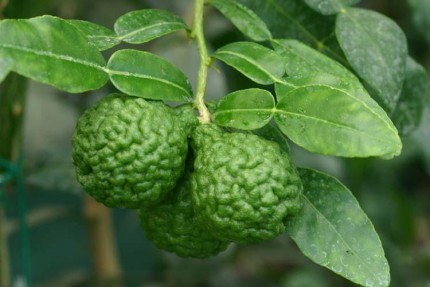Satkora (Makrut Lime)
 Monday 30 November -0001
Monday 30 November -0001
Other Local Name : 0
Botanical Name : Citrus hystrix
Family : Rutaceae
Main Use : Fruit
Other Uses : Fruit
Know More
Citrus hystrix DC. (Bengali name- Satkora; Family-Rutaceae) is a small and bushy tree, about 3-5 m tall, which grows well in Jayantapur, Gowainghat and Moulobibazar of Bangladesh, Khasia hills of Assam, India and South East regions of Asia. Citrus hystrix is a thorny bush, 6 to 35 feet (1.8 to 10.7 m) tall, with aromatic and distinctively shaped "double" leaves bearing rough, bumpy green fruit. The green lime fruit is distinguished by its bumpy exterior and its small size (approx. 4 cm (2 in) wide).
Citrus hystrix sometimes referred to in English as makrut lime (see below), Mauritius papeda or kaffir lime. It is a fruit native to tropical Asia including Bangladesh, India, Nepal, Bangladesh, Thailand, Indonesia, Malaysia and the Philippines. The Oxford Companion to Food (ISBN 0-19-211579-0) recommends that the name makrut lime be favored over kaffir lime because Kaffir is an offensive term in some cultures and has no good justification for being attached to this plant.
The rind of the kaffir/makrut lime is commonly used in Lao and Thai curry paste, adding an aromatic, astringent flavor.The zest of the fruit is used in creole cuisine to impart flavor in "arranged" rums in the Martinique, Réunion island and Madagascar. However, it is the hourglass-shaped leaves (comprising the leaf blade plus a flattened, leaf-like leaf-stalk or petiole) that are used most often in cooking. They can be used fresh or dried, and can be stored frozen. The leaves are widely used in Thai and Lao cuisine (for dishes such as tom yum), and Cambodian cuisine (for the base paste "Krueng"). Kaffir/Makrut lime leaves are used in Vietnamese cuisine with chicken to add fragrance. They are also used when steaming snails to decrease the pungent odor while cooking. The leaves are also used in Indonesian cuisine (especially Balinese cuisine and Javanese cuisine), for foods such as Soto ayam, and are used along with Indonesian bay leaf for chicken and fish. They are also found in Malaysian and Burmese cuisines. The juice is generally regarded as too acidic to use in food preparation. In Cambodia, the entire fruit is crystallized/candied for eating.
The juice and rinds are used in traditional medicine in some Asian countries; the fruit's juice is often used in shampoo and is believed to kill head lice.
The juice finds use as a cleanser for clothing and hair in Thailand and very occasionally in Cambodia. Lustral water mixed with slices of the fruit is used in religious ceremonies in Cambodia.
The compound responsible for the characteristic aroma was identified as (–)-(S)-citronellal, which is contained in the leaf oil up to 80%; minor components include citronellol (10%), nerol and limonene.
From a stereochemical point of view, it is remarkable that kaffir/makrut lime leaves contain only the (S) stereoisomer of citronellal, whereas its enantiomer, (+)-(R)-citronellal, is found in both lemon balm and (to a lesser degree) lemon grass, (note, however, that citronellal is only a trace component in the latter's essential oil).
Kaffir/Makrut lime fruit peel contains an essential oil comparable to lime fruit peel oil; its main components are limonene and β-pinene.